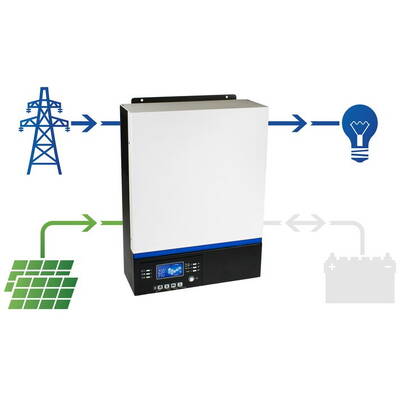The photovoltaic (PV) inverter is a critical component in a solar power generation system. Its primary function is to convert the direct current (DC) electricity generated by the solar panels into alternating current (AC) electricity that can be used to power homes and businesses or fed into the grid. Here’s a brief overview of the working principle of a PV inverter in a solar power generation system:
- DC to AC Conversion:
- Solar panels generate DC electricity when exposed to sunlight. This DC electricity consists of voltage and current that can vary depending on the sunlight intensity and the configuration of the solar panels (series or parallel). However, most household and grid applications require AC electricity for compatibility with standard electrical appliances and the grid.
- Rectification:
- The first stage of the PV inverter’s operation is the rectification of the incoming DC power. This process involves converting the variable DC power from the solar panels into a stable DC voltage. This is achieved by using power electronics components such as diodes and insulated gate bipolar transistors (IGBTs).
- DC Bus Voltage:
- The stable DC voltage is then used to create a DC bus voltage. The DC bus voltage serves as a foundation for generating AC power and maintaining the inverter’s control functions.
- Pulse Width Modulation (PWM):
- To create AC power, the inverter uses a technique called Pulse Width Modulation (PWM). PWM involves rapidly switching the DC voltage on and off to create a series of pulses. The width (duration) of these pulses determines the amplitude and frequency of the output AC voltage, effectively simulating a sine wave.
- Filtering and Output:
- The pulsed waveform is then passed through an output filter, which smoothens the waveform to resemble a sinusoidal AC voltage. The result is a stable AC output voltage at the desired frequency (usually 50 Hz or 60 Hz) and voltage level (e.g., 220V or 120V), suitable for powering electrical loads.
- Grid Interaction (if applicable):
- In grid-tied systems, the PV inverter must synchronize its output with the grid’s voltage and frequency to safely feed excess power into the grid. This is achieved through a process called grid synchronization, which ensures that the inverter’s AC output is in phase with the grid’s AC power.
- Maximum Power Point Tracking (MPPT):
- Some advanced PV inverters incorporate Maximum Power Point Tracking (MPPT) algorithms. MPPT continuously adjusts the inverter’s operating conditions to extract the maximum power from the solar panels by optimizing the voltage and current at which they operate.
- Monitoring and Control:
- PV inverters often include monitoring and control systems that track the system’s performance, provide data to users or system operators, and ensure safety and reliability. These systems can communicate with external devices or be accessed remotely for real-time monitoring and diagnostics.
In summary, a photovoltaic inverter plays a crucial role in converting the DC electricity generated by solar panels into usable AC electricity for homes, businesses, or the grid. It involves rectification, PWM modulation, output filtering, and often grid synchronization and MPPT to maximize energy production and system efficiency.


